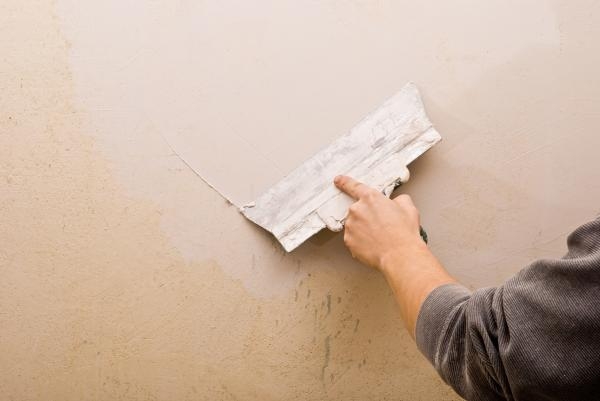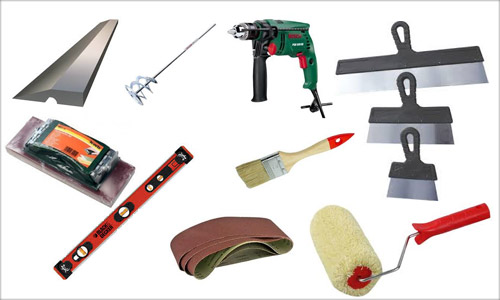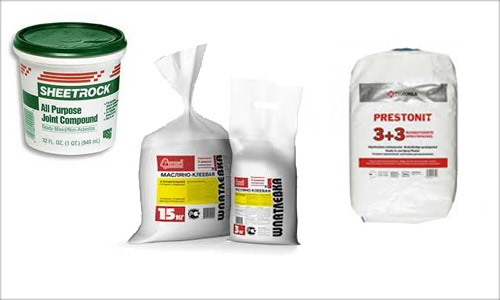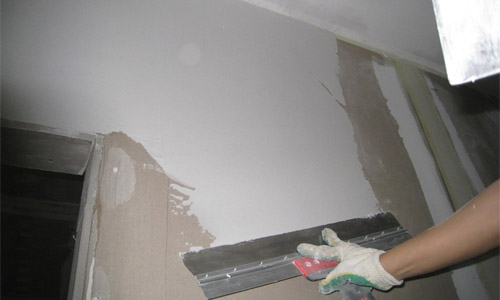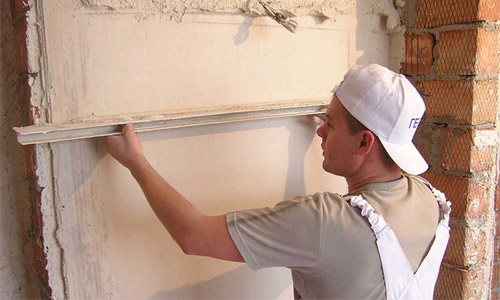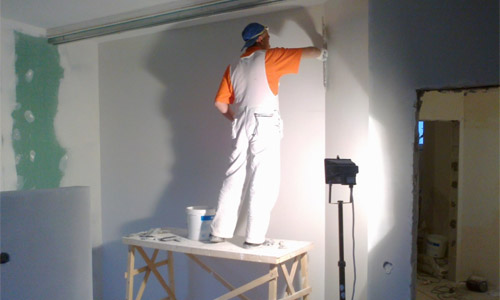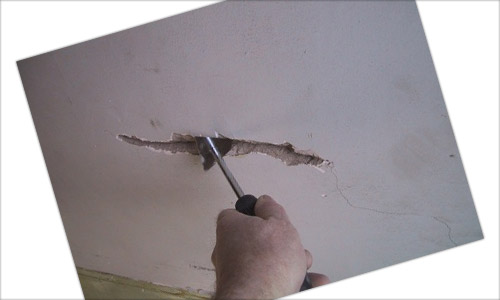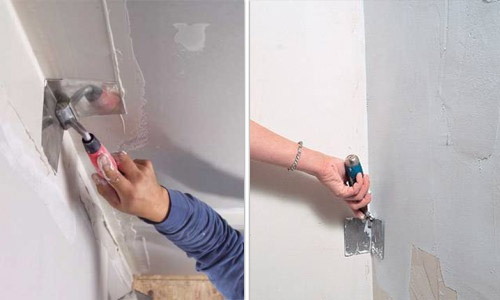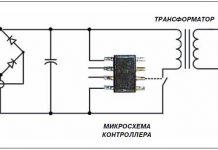In detail: DIY repair putty from a real master for the site my.housecope.com.
When starting repairs in the house, you should draw up an accurate, all-encompassing work plan and strictly follow it. Particular attention should be paid to the walls. Unfortunately, not a single paint, whitewash or wallpaper can hide the cosmetic defects and imperfections of the wall panels. Even in a new, just rebuilt building, the quality and evenness of the walls leaves much to be desired, which means that you will have to do something yourself.
Puttying the walls with your own hands
Contents of step-by-step instructions:
Putty is the building material that allows you to level the walls and get rid of cracks and irregularities before finishing or decorating walls or other panels, which will allow you to make quality repairs.
Manufacturers of building materials offer ready-made and dry putties, sold in bags in the form of mixtures. Choosing here or another form of material release, you should pay attention to the marking indicated on the package. The letters KR or LR mean that the putty is intended for ordinary rooms, and the VH marking means use for rooms with high humidity.
-
Oil-glue putty based on drying oil. This type of putty is unsuitable for leveling concrete and brick walls, since it is almost completely absorbed into the wall, and later appears as stains through all finishing materials, except for wood panels and oil paint, therefore it is used for processing wooden walls.
Oil and glue putty based on drying oil
There is no tangible difference between a ready-made putty and a dry mixture. There are small nuances, such as additional additives, the maximum layer thickness obtained in one application.
| Video (click to play). |
An open can or a prepared amount of a putty mixture must be used within 24 hours, otherwise it will lose all its properties, it will be difficult and poorly applied, and a good result when working with such a tool is not guaranteed.
There are also starting and finishing putties designed for certain stages of puttying.
To dilute the dry mix you will need:
- dry putty mixture;
- water;
- mixing container;
- construction mixer or drill with a special attachment.
Usually the putty is diluted in the ratio of 1 liter of cold water to 2.5 kg of dry mix.
- Cold water is poured into a prepared clean bucket.
- The measured amount of the mixture is poured. It is advisable to evenly pour the powder into the water - this prevents the formation of clots of the building mass.
Kneading putty from dry mix
The resulting putty mixture should be close in consistency to thick sour cream. A too liquid composition will flow down the wall, a thicker one will clump in a limited area, preventing an even layer of the product from being applied.
It should be remembered that the resulting mixture can neither be thickened with an additional portion of dry powder, nor diluted with water. Particular attention must be paid to prevent the ingress of foreign inclusions and dirt (particles of old material from the mixer, small stones, etc.).
Puttying - the process is not so complicated and can be done independently. Various tools are required to work.
-
Spatulas vary in size from small to large (some wall areas will require spatulas up to 60 cm long). The blades of working trowels must be even and smooth, without chipping. In case your spatulas do not meet this requirement, you need to lightly process the surfaces with fine sandpaper.
Dedicated sandpaper holder
PVC corner profile with reinforcing mesh
The whole process of applying the putty material can be broken down into successive stages.
Removing old paint or wallpaper and cleaning walls
The main task of this stage is to make the walls as clean as possible. For this, all stains (rust, dirt, grease) must be removed. Places of localization of mold - treat with specially designed compounds. All decorative and cladding materials must be removed from the walls. Old plaster - knock down. When performing the above works, spatulas, construction washes and other solutions are used to facilitate the stage of cleaning the walls. The cleaned walls need to be dried, without a draft, on average it takes from 12 to 24 hours to dry.
Further, the quality of the walls is checked by the level or building rule. A marker is used to indicate all indentations and valleys. Roughness and protrusions are cut and sanded with coarse sandpaper.
Important! It is not recommended to make any manipulations over the frozen walls and ceiling. In this case, there is no guarantee that the material will hold in place and the coating will remain intact.
Many neglect the priming of the walls, which is absolutely in vain. The surface treated with a primer acquires greater strength and lends itself better to puttying, due to the good adhesion of the putty mixture to the primed wall.
"Clean" walls are primed in two layers, if plastering of the walls is supposed to be enough and one layer of primer before puttying. The primer creates a thin film on the wall surface and protects against the development of mold and mildew.
Principles of applying putty on the wall
Principles of applying putty on the wall
For work, you will need two spatulas - an average one for gaining the working mass from the container and distributing it with a uniform comb over a larger spatula, which will level the putty along the wall. "Working" trowels can vary depending on the section of the wall.
Experts advise starting from the left edge and moving clockwise. The wall is slightly overlapped, trying to level the putty mixture as much as possible. It is important to avoid applying too much putty. The spatula should be moved diagonally, imitating the movement of car wipers, by passing the tool along the wall at an angle of 30-35 degrees towards yourself and without too much pressure.
It is important to let each layer dry thoroughly - this will serve as a guarantor of a strong and durable coating.
How do I process corners?
To get a perfectly even angle, you can use a special angled spatula. The main nuance is that the putty mass is applied to the wall itself and leveled with a spatula from top to bottom.
There is a variant of using a corner profile, which is glued into the corner before the first puttying or plastering. However, this method is not applicable if the walls are being prepared for painting.
In this case, you can leave more filler in the corners and bring the joints of the wall panels to perfect condition during the final sanding stage.
The first layer is usually the densest. If the walls are too uneven, then a special mesh is attached over the entire surface area, which is glued with construction glue. If the walls are flat enough, then the paint net is glued only in the corners (internal and external). The stronger and tougher the material, the smoother the putty surface will be.
Wall putty on a polymer mesh
If there are grooves and deep cracks in the walls, then the putty is first applied locally, having previously primed the crevice, and then the entire wall is treated with the putty.
Construction brands offer special starting putties for this stage, which have higher elasticity and allow you to apply a layer up to 1 cm thick. But such a layer will also dry for at least 24 hours. The recommended starting layer thickness is 5 mm.
This stage of work is similar to the previous one, only during its execution the evenness of the wall is constantly checked by the building rule or level. The second layer is much thinner than the first.
Putty using beacons
An important point: making the second puttying, you need to "stretch" the surface as best as possible, giving it maximum evenness.
Final third putty
The thinnest layer, its thickness is not more than 2.5 mm. For this stage, there are also special mixtures, the main task of which is to give the surface smoothness. But, if the previous steps were performed poorly, this layer will not be able to correct the situation.
The plastered walls are dried with closed windows and temperature changes. Sharp fluctuations in thermal conditions and drafts can cause cracks and deformations in the putty coating. Drying using electrical installations and heaters is inadmissible. That is, you need to dry the room with the windows closed, but the interior doors open.
It is recommended to withstand the final drying for about a day, so flaws and shortcomings that were not seen during work will be visible, and the coating itself will better adhere to the wall.
Sanding of walls after putty
To give the wall its final smoothness, it must be sanded using the holder. It is important to understand that when preparing walls for gluing wallpaper, it is necessary to sand with an abrasive with a grain size in the range from P80 to p120. When preparing the wall for painting - from P120 - P150, after which the wall is primed and dried again.
Correctly plastered walls are the key to any high-quality repair
Puttying is not a very difficult process, but it requires patience and certain skills in working with a spatula and tools.
High-quality preparation of walls for various finishing works consists in obtaining a flat, smooth surface. To do this, it is necessary to competently perform priming and puttying. Puttying is not difficult. The main thing here is to follow the procedure and be able to properly handle a construction tool. How to properly putty the walls on our own without resorting to the help of specialists, we will consider in this article.
To putty the walls yourself, prepare a minimum set of tools. What tools can't you do without?
1. A drill equipped with a special attachment - a mixer. Typically, putty is sold as a dry mix. Water is added to such a mixture in a certain proportion. Only with a special mixer can you perfectly stir the putty mixture. The output should be a homogeneous putty without lumps.
2. A set of spatulas. Be sure to choose a trowel of different sizes. In work, you will have to use both large spatulas (40-50 cm) and very small ones. Indeed, in problematic hard-to-reach places, it will not be possible to properly putty the wall with a large spatula. This is exactly what small spatulas are used for.
3. Rollers and brushes for priming walls. It is undesirable to skip the priming stage. After priming, the wall is covered with the thinnest film. This not only further increases its strength, but also provides excellent adhesion of the treated wall to any facing materials (adhesion).
4. Rule. It will be necessary in the case of uneven walls when you have to apply the putty in a thick layer. For smoothing thick layers of putty, it is convenient to use a long metal rule.
5. Spirit or laser level. Often the surface of the wall is very uneven. Before starting the starting putty, check beacons are installed using an alcohol or laser level for checking.
6. Sandpaper. If you want a beautiful surface that is pleasant to look at, use fine skins for mashing. For example, grouting with 240 sandpaper will give you the perfect finish. Use the finest sandpaper only for finishing putty.And at the stage of the starting initial putty, it is correct to rub the wall with a coarse coarse sandpaper.
7. Manual skinner. Grouting with sandpaper will become much more convenient if you use a manual skinner. This is a tool on the handle of which special clamps are installed to secure the skin.
8. And, of course, you cannot do without a container in which the putty is stirred.
A list of tools you may need to putty your walls. Photo - my.housecope.com/wp-content/uploads/ext/1520
Classification of putty by composition: gypsum, polymer (acrylic) and cement.
Let's consider their advantages and disadvantages.
1. Plaster putties are attractive at an inexpensive price, lend themselves well to leveling, do not shrink. The only drawback is poor moisture resistance. This alone limits the scope of their use.
2. Cement putties are distinguished by excellent moisture resistance, but have a significant drawback - a large degree of shrinkage.
3. And finally, polymer putties. Undoubted advantages: excellent moisture resistance, do not shrink at all. With the help of polymer putty, high quality of the treated wall surfaces is obtained. The only drawback is the high price.
According to their purpose, putties can be divided into starting (leveling), decorative (finishing) and universal.
1. Characteristics of leveling (starting) mixtures: high strength, excellent adhesion, large grain size. Recommended: for leveling walls after plastering. Application thickness: 3 -20 mm.
2. For high-quality performance of decorative finishing, it is advisable to apply finishing putties on the surface to be treated. With their help, you can get a perfectly smooth, even surface, hiding small flaws. The strength of the finishing putty is less than the starting one, its processing does not cause difficulties. It is applied in a small layer up to 4 mm.
3. Universal fillers combine the properties of decorative and leveling compounds. They are more expensive, although in terms of properties they are slightly inferior to the finishing and starting coatings. We recommend using it when processing walls without major flaws.
The modern market offers dry and ready-to-use putties. It is attracted by the low cost of dry putty and the possibility of its long-term storage.
It is convenient to use ready-made putties. You do not have to use a mixer to prepare a homogeneous putty mixture. This saves time and virtually no dust. But ready-made putties are much more expensive than dry ones. Please note: such putties give a lot of shrinkage. If a layer less than 2 mm thick is applied, ready-made fillers cannot be used. They also do not boast of a long shelf life. It is significantly less than dry building mixtures.
Dry in bags and ready to use in a bucket of putty.
The main thing is to make sure that the surface of the walls is absolutely clean. Be sure to remove grease, paint or grime stains. Of course, there should be no loose plaster layers, residues of scale, wax or parts of the formwork. Do not even start to putty the frozen ceiling and walls. This is strongly discouraged.
Before applying putty, coat the walls with a primer. This will ensure good adhesion (connection) of the filler to the walls. The surface is primed with a special roller. Try to apply the primer solution evenly, avoiding gaps. One layer is enough.
There are such types of putty: finishing, lighthouse, starting. Let's take a closer look at the properties and scope.
The putty is carried out using a coarse starting material. It is not difficult to find it. When buying, it is called that - starting putty. To remove large wall drops, hide grooves, holes, it is convenient to use such a putty. The thickness of a layer of such a putty, applied at a time, can reach 1.5 cm.Let the previous coats dry completely. Only then proceed with the application of the next layer of putty.
In order to obtain the highest possible quality of the putty surfaces, a special painting net is installed on the wall, and the putty is distributed on it evenly over the entire surface. At the same time, the walls are completely solid. The advantage of this technology is that when using a paint grid, the putty adheres perfectly to the surface of the walls. And the surface itself becomes more durable and even. Moreover, the rougher the painting net, the smoother the treated wall surface.
Starting plaster of the wall.
The materials do not differ from the starting putty. The only difference is that beacons are used. A lighthouse is a wooden, plaster or metal lath, which is positioned strictly vertically, checking the verticality with a level. The lighthouses are attached to the walls with the help of some kind of gypsum mixture, it dries quickly, after which you can proceed directly to puttying. The horizontal lines are aligned in the same way. In this case, the rule will come in handy for leveling the layer of putty. Following these recommendations, after starting work, a flat surface is obtained. To make sure of the quality of work, you can check the level. This type of finish is rarely used. The reason: its cost is much higher than the starting putty, although visually they are almost the same.
Plastered walls on lighthouses. Photo –p> After finishing the starting or lighthouse putty, proceed with the finishing putty. It is done with finishing putty mixtures. It is this putty that gives the wall surfaces an ideal smoothness. The smallest cracks or pores are eliminated. It is important that the finishing putty completely coincides in plane with the previously prepared surface, therefore it must be applied in a very small layer. If the starting or lighthouse putty is performed poorly, you will not be able to correct the situation with the finishing putty. Therefore, in the beginning, try to make the surface of the walls perfectly flat. Only then proceed with the finishing putty. Its main goal is a beautiful smooth wall surface.
The finishing putty is made under special lighting, this allows you to see the smallest irregularities. Photo –p> To hide the cracks in the walls, we recommend using gypsum mixtures for the putty. Santegypsum material is much more elastic in work, but it hardens much longer. Advice from competent specialists: at first it is recommended to slightly widen the crack, slightly increase its depth and thickness. To increase the roughness, you can scratch it with a knife or other sharp object along its entire length. Then treat it thoroughly with a primer. Only then proceed with the putty.
Opening cracks for putty. Photo - dekoratik.com
1. In case of using dry putty, it is necessary to correctly prepare the putty mixture.
Cooking sequence:
- pour a small amount of water into the container;
- add putty;
- stir with a simple spatula;
- to obtain a homogeneous mixture, use a drill with a mixer, gradually adding water if necessary.
Note: the readiness of the putty should be determined by its consistency. It should become elastic and stick a little to the spatula. If the putty mixture flows down, then it is watery. Add dry mix little by little to remedy the situation. If there are lumps in the putty, it means that the putty is too dry. Add water little by little, stirring well, to achieve perfect uniformity.
2. Apply the starting putty. It is convenient to use a large spatula. Apply the putty in medium batches, spreading evenly over the surface. Hold the spatula at an angle of about 30 degrees. The putty is applied diagonally with one stroke.Recommendation: To avoid transitions and bumps, overlap each layer.
3. For smooth corners, we recommend using an angled trowel. Work technology: first, with a small spatula, apply a small layer of putty along the entire height of the corner or slope. Then carefully smooth the surface with an angled trowel. During the day, the layer of putty should dry well.
To putty the corners, you will need a special corner trowel.
4. Once the starting filler is completely dry, proceed with the finishing filler. A large and small spatula are used for work. Put putty in small portions on a large spatula with a small spatula. Then we evenly apply the putty mixture to the surface. The layer thickness is about 1.5 - 2 mm.
5. Before puttingty the paintable wall or wallpaper, wait until the previous layers are completely dry. The starting and first layer of the finishing putty must be absolutely dry. This takes approximately 12 hours. Then you can apply the finishing putty.
6. When completely dry, proceed with final sanding with sandpaper.
Attention: before applying each next layer of putty, it is advisable to treat the previous one with a primer.
The walls are pre-leveled with several layers of putty. If the wallpaper is thick, it is advisable to apply the putty in two layers. When using thin wallpaper, we recommend applying three leveling coats of putty. This will allow the wallpaper to stick to a flat surface without wrinkles or bubbles.

